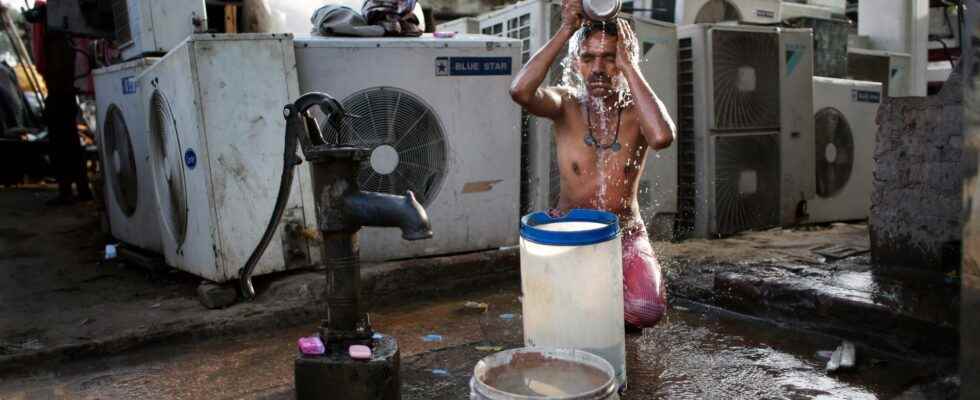full screen
Next
In India, about one billion new air conditioners are expected to be sold in the coming decades. Stock Photography from Delhi.
1 of 2Photo: Altaf Qadri / AP / TT
It can be described as one of the great paradoxes of climate change. As extreme heat becomes more common, the technology that humans are cooling off will help to heat the planet further.
It’s not even July. But it’s so hot in Magnolia, Texas, that 48-year-old April Turgutalp prefers not to go out. And if she does, it’s to cool off in the pool. The nights no longer offer a break in the relentless heat wave that recently swept across the United States and prompted authorities to urge millions of Americans to stay indoors.
– It’s hot as hell during the day, Turgutalp tells The Guardian.
– I promise, it’s cooler when I open the oven door than when I open the front door. If we did not have air conditioning, we would have already died of heat stroke.
Early heat
It is not just the United States that has been hit by the heat wave. In Europe, the heat has hit unusually early in the summer, resulting in water rationing, drought and fires. India and Pakistan have also struggled with high temperatures early in the season – heat that has tested the limits of what humans can do.
Climate change will make heat waves more common, longer and stronger. And as temperatures rise, access to air conditioning can be a matter of life and death. Heat is sometimes called a “silent killer” because the symptoms of heat-related illness often pass unnoticed until it is too late. Organs can collapse and pre-existing problems such as cardiovascular disease or diabetes worsen.
About 90 percent of the population in the United States is estimated to have air conditioning at home, but in Europe the supply is more uneven. In Spain, it is found in about a third of all residential buildings, while the figure for France and Germany is around five percent, although the proportion is believed to have increased given the extreme heat of recent years.
Increased demand
Of course, the greatest need for air conditioning is in warm countries, although supply is limited. But that is changing.
About half of the world’s installed capacity of air conditioning is in the United States and China, but by 2050 the number is expected to grow at ten plants per second, according to the International Energy Agency IEA. The fastest increase is expected in countries such as India, Pakistan and Indonesia, where people getting out of poverty often prioritize refrigerators over other purchases.
– It is not only a result of climate change, but there is a growing middle class in developing countries where those who can buy the air conditioning service do so, says Carlos Lopes, senior adviser at the Swedish Energy Agency, to TT.
– More and more people are equipping themselves and there is a reason for that because high temperatures can be dangerous.
Emissions of carbon dioxide
But there is a paradox in the struggle to stay cool when temperatures rise – because while the appliances provide cold, they can ultimately aggravate the problem they are trying to solve. Many plants consume energy, including fossil fuels, which emit greenhouse gases that heat the planet.
– Air conditioning consumes a lot of electricity and in many developing countries it is coal that will be burned, which exacerbates global warming. Large investments will also be required to expand the electricity grid, says Lopes.
– When the heat waves come earlier, last longer and have greater effects, it also leads to many spontaneous purchases, sometimes of rather poor products for air conditioning.
However, there are several ways to keep energy consumption down as the craving for air conditioning increases in the world. In the EU, for example, the requirements for companies to manufacture energy-efficient air conditioners are being tightened regularly.
“Increase acceptance”
But Lopes also emphasizes the importance of people learning to adapt to warmer temperatures as far as possible. An example is a campaign in Japan, where air conditioning was first used at 28 degrees and officials were therefore encouraged to ignore the usual and sweaty dress code tie and dark jacket. Other examples of passive solutions are curtains, awnings and ventilation.
– It is also important to build smart. Most EU countries have rules regarding energy use in new construction or renovation to avoid or reduce the need for cooling, says Lopes.
This applies, for example, to the design and orientation of a building to avoid direct sunlight in the summer.
– But you also do not need to have 21 degrees indoors in both winter and summer. It is important to have a certain acceptance of what is perceived as uncomfortable and learn to live with the weather.
Facts
Stressful for health
With climate change, heat waves are expected to become more common.
Persistent periods of heat during the summer can cause health problems and increased mortality. This is especially true when the heat is high throughout the day. When the nights are warm, the body does not have time to recover and it can be difficult to lower the temperature indoors.
The negative health effects of heat include relatively mild symptoms such as dehydration and impaired general condition but also more severe symptoms such as heat stroke and heart attack. Negative health effects often occur on the same day or after one to two days after high temperatures have been noted.
Risk groups for heat waves are the elderly, the chronically ill, people with disabilities, young children, pregnant women and people who take certain medications that affect the body’s ability to adapt to body heat and fluid balance.
Source: Swedish Public Health Agency
Read more
